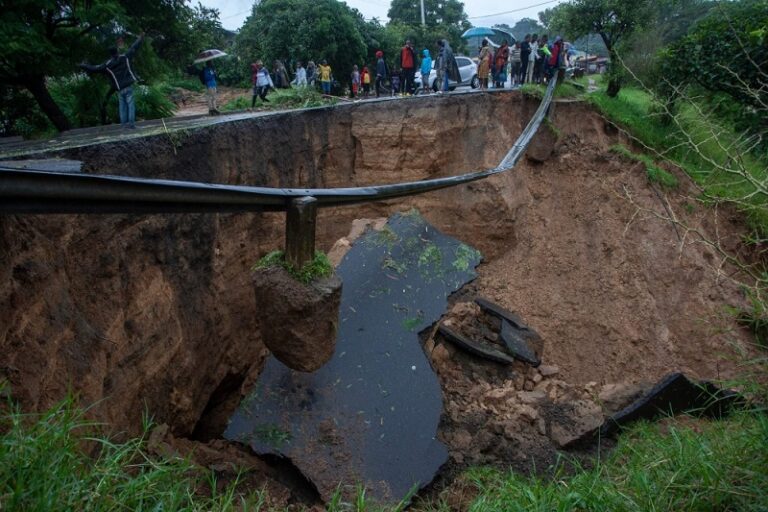

after a deadly cyclone returned, malawi declared a state of emergency.
Tropical Storm Freddy tore through southern Africa for the second time in one week over the weekend, killing more than one hundred people, injuring scores more, and leaving a path of devastation in its wake. On Monday, Mozambique and Malawi were assessing the damage caused by Freddy, which had ripped through the region over the weekend.
According to the World Meteorological Organization, Freddy is one of the most powerful cyclones that has ever been documented in the southern hemisphere, and it has the potential to be the tropical cyclone that lasts the longest. On Saturday, it pounded the central region of Mozambique, ripping roofs off of structures and bringing widespread flooding around the port of Quelimane. After that, it moved inland toward Malawi with torrential rains that caused landslides.
Because the power supply and phone signals were disrupted in some areas of the affected area, it is not yet possible to determine the full extent of the damage and the number of lives that were lost in Mozambique in particular. According to the commissioner of the Department of Disaster Management Affairs, Charles Kalemba, who spoke at a press conference, the storm has claimed the lives of 99 people in Malawi, with 85 of those deaths occurring in the principal commercial hub of Blantyre.
Since it first made landfall a month ago, Tropical Storm Freddy has been responsible for approximately 136 deaths across the three countries of Mozambique, Malawi, and Madagascar.
Doctors Without Borders (MSF) country director Marion Pechayre told Reuters by telephone that the central hospital in Blantyre had received at least 60 bodies by the early afternoon. She also stated that approximately 200 wounded people were being treated in the hospital at the time.
She stated that the injuries were sustained as a result of collapsing trees, landslides, and flash floods. Many of the houses are made of mud and have zinc roofs; as a result, the roofs frequently collapse on the occupants’ heads. Chilobwe and Ndirande are two of the worst-affected townships in Blantyre, the country’s second-largest city, where it was still raining on Monday and many residents were without electricity. According to police spokesperson Peter Kalaya, who spoke to Reuters, rescue teams have been searching for people in these townships. Kalaya stated that there is a possibility that some of the missing individuals are buried under the debris.
The national electricity company of Malawi, known as EGENCO, reported that the country’s power generation capacity was unstable and that the company had experienced complete system shutdown twice on Monday. According to what it said, it has shut down all of the important hydro power stations in order to safeguard them from damage.
Nelson Ludovico, a provincial delegate from the National Institute of Disaster Risk Management in Mozambique, stated on Radio Mozambique that the death toll in the province of Zambezia in Mozambique is at least ten, adding that the numbers are still provisional. Radio Mozambique is a public broadcaster.
“The situation is critical in Zambezia district. There is no communication with all of the regions, so we are unable to advance with an accurate picture of the scale of the damage,” Health Minister Armindo Tiago said on public radio. Guy Taylor, who works for the United Nations Children’s Fund (UNICEF) in Mozambique and is in charge of advocacy, communications, and partnerships, told Reuters from Quelimane that the country’s humanitarian groups didn’t have the resources they needed to respond to a disaster of this size.
“We saw a lot of damaged clinics and buildings,” the witness said. The wind ripped the roofs off of people’s houses and caused damage to the homes. Even before the eye of the hurricane made landfall, we had already seen some localized inundation, he said. The wind had died down by Monday, but there was still a significant amount of flooding, which, according to him, had resulted in the destruction of crops and produced the possibility of waterborne diseases.
In the past month and a half, Mozambique has received more rain than it normally receives in an entire year. The current cholera outbreak in Malawi is the deadliest in the country’s recorded history, and various United Nations agencies have cautioned that the situation could deteriorate further.
Scientists believe that climate change brought on by the burning of fossil fuels is making tropical storms more powerful. This occurs because the oceans capture heat from greenhouse gas emissions, and when warm seawater evaporates, it transfers thermal energy to the atmosphere.
Also Read:- As the jihadi threat grows, the US is training West African militaries
UNICEF reported that, nearly 2900 people died of cholera across Eastern and Southern African countries while children suffer most greatly…
Enza, based in the United Arab Emirates, obtained $6.75 million in initial investment funding from Algebra Ventures and Quona Capital.…
US Secretary of State Marco Rubio ordered South African Ambassador Ebrahim Rasool to leave America by March 21 because he…
Early 2025 ends with IPL fever in India and cricket fans receive good news of an international schedule full of…
National teams from Africa advance their World Cup qualification pursuit as they take part in Matchday 5 of the qualifiers.…
Creative Africa Nexus (CANEX) is running the Book Factory Prize for Publishing in Africa again to award $28,000 to African…
This website uses cookies.